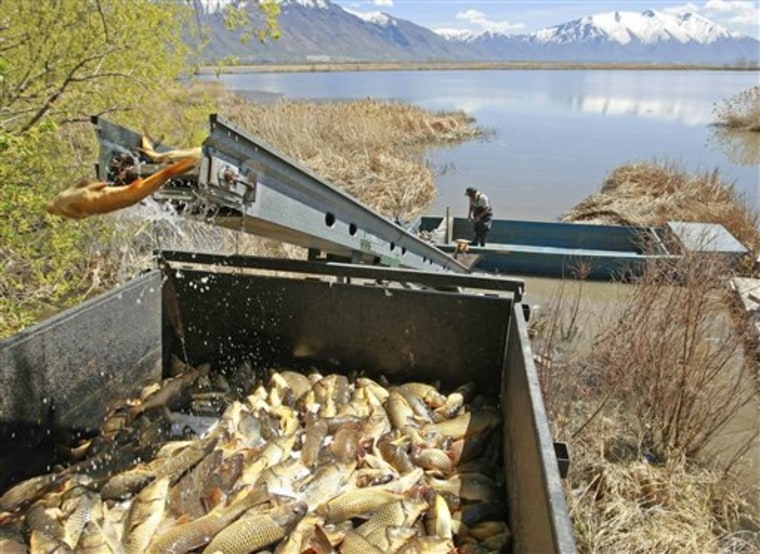Carp diem, Utah.
State officials are about to embark on what they believe is the nation's biggest carp removal project.
Biologists say removing 5 million pounds a year from Utah Lake — roughly the equivalent weight of 1,500 Volkswagen Beetles — is their best shot at saving the rare and endangered June sucker, a native fish that only lives in the lake and its tributaries.
As they feed along the lake bottom, carp tear up vegetation that provides vital hideouts for young June suckers looking to avoid predators.
Over the fall and winter, a commercial fisherman and his crew pulled 1.4 million pounds of carp out of the lake. The success of that pilot program was enough for the U.S. Fish and Wildlife Service this month to contribute $1 million to ramp it up. That money, along with $510,000 in state funds, will allow fisherman Bill Loy to hire a crew of 10, buy more equipment and get after the carp twice as hard this fall. Longer-term funding hasn't been secured.
"I think I could get 80 percent of them out," the 52-year-old Loy said while standing ankle-deep in dead carp aboard a homemade flatboat moored at the lake's marina west of Provo.
30 million pounds in 6 years?
If the plan works — success in this case means pulling some 30 million pounds of carp out of the water over the next six years — Utah Lake could become a model for scores of other lakes plagued by carp.
"They're a problem everywhere," said Reed Harris, director of the Utah's June sucker recovery program.
The U.S. Geological Survey says common carp have a foothold in nearly every state. Many of the populations were planted. In Utah Lake, they were introduced in the 1880s as a source of food for local residents.
These days, they're mostly seen as an unappetizing bottom-dweller and a pest that breeds fast, stirs up lake muck and crowds out native fish. Carp removal projects happen all over the country but few, if any, appear to be on the same scale as plans for Utah Lake, the state's largest natural freshwater lake.
"I think 90 percent of fish managers and lake managers would like to see them go away," said Harry Gibbons, president of the North American Lake Management Society. "They're a nuisance species."
Biologists estimate there are 7 million to 8 million carp in Utah Lake that make up more than 90 percent of the weight of all fish in the lake. They hope that by removing 75 percent, the carp population will crash, plants along the lake bottom will recover and the June sucker can get re-established.
23,000 pounds a day fished out
The pilot program that started last October showed signs of success.
On an average day, Loy and his crews pulled out 23,000 pounds of carp. Most of them were dumped in a farmer's field for fertilizer, sent to a nearby mink farm for food or mixed into compost.
Though plenty of ideas have been floated — including the possibility of using the dead fish for biofuels or cat food — state officials are still looking for alternatives that can pencil out financially and logistically.

"They're too many people starving in the world to throw them in a hole," said Loy, the fisherman.
Burly and sporting a bushy mustache, Loy has fished Utah Lake commercially since the 1980s. He's mostly caught and sold carp, primarily for Asian customers.
All that changed in 2006 when state officials warned against eating too much carp from Utah Lake because of carcinogens. PCB levels in the fish exceeded Environmental Protection Agency standards but not those set by the Food and Drug Administration.
Business dried up quickly after that. But Loy is back, plying the lake's 151 square miles going after the same quarry. He'd like to see the carp land on dinner plates and thinks health warnings were overblown.
"I think the stigma is part of it," said Michael Mills, local coordinator for the June sucker recovery program. "There's got to be a way to make this into a real product."
Harris said 90 percent of the world's population eats carp. The main problem at Utah Lake is the cost of delivering them to market.
"If this lake was in the Mideast, they'd be having a heyday with these fish," said Harris, who was looking into an operation that could convert the carp to fertilizer.
Those who eat carp — including thousands at a popular Nebraska restaurant called Joe Tess Place who feast on open-faced carp sandwiches — insist its taste has gotten a bad rap.
But the fish just hasn't caught on.
About $600,000 was spent between 2002 and 2008 to remove 1.3 million pounds of carp from Lake Elsinore in Southern California, according to Pat Kilroy, the lake's manager.
"We tried to find somebody who would take the fish," he said.
Instead, they ended up as compost.
At Seattle's Green Lake, 1,200 carp were removed last year and ground into fish meal.
"Most people in this country turn their nose up at it," said Bruce Bolding, a fisheries biologist with the Washington Department of Fish and Wildlife.
